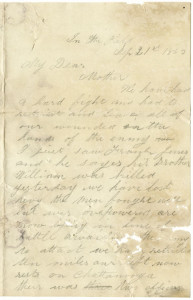The following information was taken from Ohio in the War concerning the 1st OVI and its part in the Battle of Chickamauga.
On the afternoon of September 13, 1863, the 1st OVI was recalled from Broomtown Valley. They crossed the Lookout Mountain range, moved down the valley, ascended Lookout Mountain on September 16th, and then descended at Catlett’s Gap, near Pond Springs — a march of 23 miles.
On September 18th, the 1st OVI was placed on picket duty near the right of the Union lines where there was constant firing with Confederate pickets. At 9 a.m. on September 19, the regiment was relieved of picket duty and marched to the support of General Thomas. After marching 10 miles, frequently stopping to form a line of battle, the regiment arrived and was placed in line of battle with the 2nd Division. The regiment was then directed to recover the ground lost by General Baird’s division earlier in the day. The 1st OVI took a position in the front line on the right of the Fourth Brigade. While forming their lines, the regiment was subject to heavy firing by Confederate forces. Once formed, the 1st OVI charged the Confederates and drove them back 1 1/2 miles before stopping to reform their lines.
It was now late in the day on September 19th. The Confederates brought up re-inforcements and about sunset was observed massing for an attack. “About dusk the enemy came up in great force, crushing back the right brigade and seriously shaking the center, the left of which, composed of the Fifteenth Ohio Volunteer Infantry fell back in confusion. This compelled the First Ohio (which joined the Fifteenth on the left, at an angle of about one hundred and twenty degrees) to change its position in order to confront the enemy. In performing this movement the First was compelled to fall back about one hundred and fifty yards, where it re-formed its lines. A most terrific fight ensued in the gathering darkness, added to which the smoke from the first discharge made it impossible to see anything in front but the flash of the enemy’s guns. A Rebel battery which had been brought close up to the front of the National lines lost every horse and every man by the murderous fire poured into it. Such a contest could not last long, and the fight soon ceased, the enemy having fallen back. The division (National) now received orders and fell back to a point where it had left its knapsacks, and laid down for the night.”
Early on September 20, rude breastworks were thrown up in front of Union forces, with the 1st OVI placed in the second line of entrenchments. At 8 a.m., the Confederates attacked Union lines on the left and extended his attack around the lines, but were eventually driven back. About 1 p.m. a heavy Confederate force passed around the Union left-wing and was observed moving through an open woods almost in the immediate rear of Union lines. The 1st OVI and the Louisville Legion were quickly “about-faced” and charged driving the Confederates away. The 1st OVI then returned to their previous position in the Union lines. At sunset on September 20, Union forces under General Thomas, including the 1st OVI, received orders to fall back to Mission Ridge. The 1st OVI fell back to Rossville, where breastworks were thrown up in case of Confederate attack.
September 21st was spent awaiting an attack, which did not come. Shortly after the 1st OVI arrived in Rossville, William Patterson wrote a letter to his mother reporting that he had survived the battle and closed with the comment “Thank God for Sparring me so far.” (Transcript of William Patterson Letter, September 21, 1863)
Finally, at noon on September 22, Union forces withdrew and marched into Chattanooga. The 1st OVI was assigned a position on the left of the Chattanooga road, its right resting on a bridge over Chattanooga Creek. The 1st OVI held this position — fighting by day and building earthworks by night — until September 25th when it withdrew to a second line of works.
The 1st OVI lost 120 men, either killed or wounded, during the battle, most of which were lost during the fight on the evening of September 19th. Overall, Union forces suffered approximately 16,170 casualties and Confederate forces 18,454.
This was the largest battle and last Confederate victory in the western theater of the Civil War.


